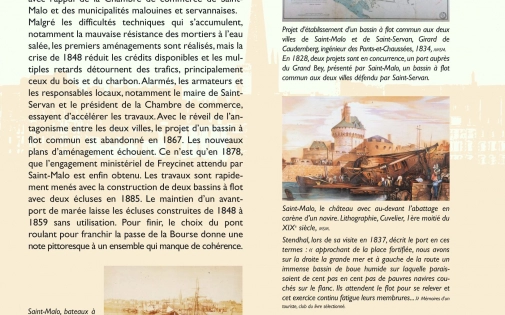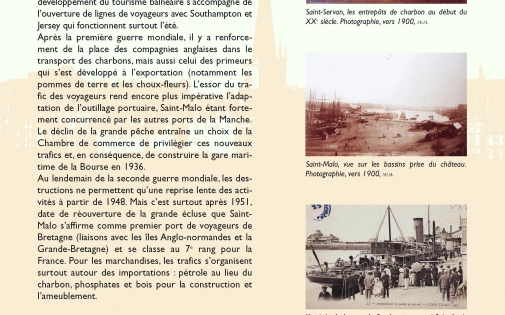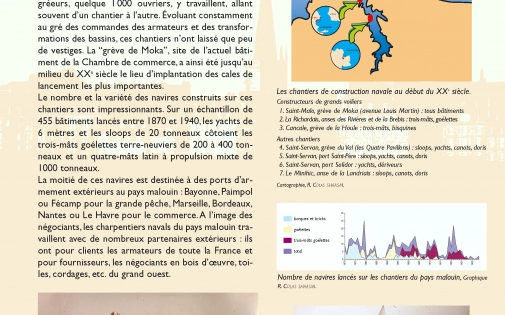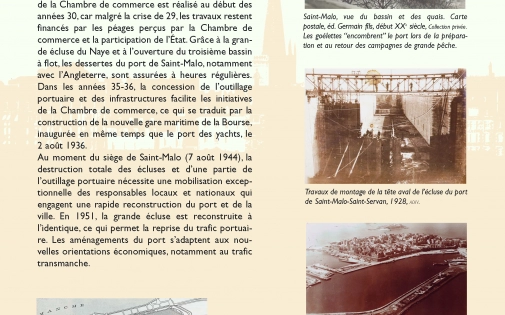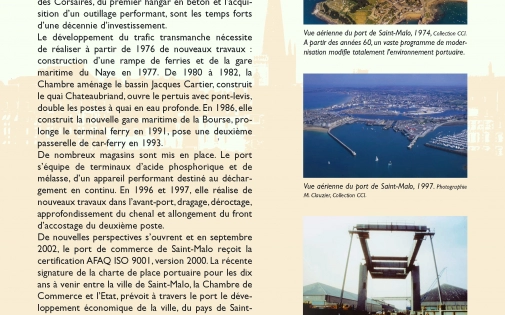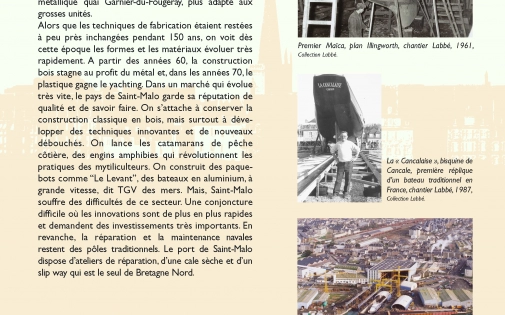SAINT-MALO, THE PORT ROLE IN THE CITY’S HISTORY
Before 1965
SAINT-MALO, THE PORT ROLE IN THE CITY’S HISTORY
Before 1965
In the 12th century, Saint-Malo received the preference of sailors and merchants because of its qualities as a port site for stranding. The idea of transforming the stranded port of Saint-Malo into floating basins, in order to adapt the port to the activities of maritime trade (passengers and goods), shipbuilding, fishing and consolidating the square of Saint-Malo among the nine ports of the Channel, date from the end of the 17th century.
In 1884 and 1885, two basins were inaugurated and in 1931 the large lock was built, closing the port and creating four basins. The port of Saint-Malo has finally different kinds of equipments (locks, quay lines, docking areas, storage area, etc.).
Meanwhile, near the port of Saint-Malo, the railway station was built in 1864.
The increase in traffic before the First World War reveals shortcomings in the port’s tool.
A modernisation programme was carried out in the early 1930s, despite the crisis of 29.
On August 7, 1944, the Germans who had mined the harbour, blew up the docks and locks. The “Môle des Noires” (big pier at the limit of the outer port) was also damaged. Some 100 boats were sunk. The city was devastated.
The reaction was immediate, the reconstruction of the port and the city of Saint-Malo spread from 1946 to 1965.
Download: The development of the port of Saint-Malo between 1803 and 1900
Download: Shipbuilding at the port of Saint-Malo between 1803 and 1940
Download: The traffic of the port of Saint-Malo between 1803 and 1965
1965, THANKS TO AN EXTENSIVE PROGRAMME OF IMPROVEMENTS
Traffic is picking up again
1965, THANKS TO AN EXTENSIVE PROGRAMME OF IMPROVEMENTS
Traffic is picking up again
- Passenger traffic
In 1965, a regular line with the Channel Islands was created, then with Great Britain in 1976. Saint-Malo quickly became the first passenger port in Brittany.
- Freight traffic
The port is equipped with phosphoric acid and molasses terminals with a powerful device for continuous unloading. Trade in goods is no exception. In 1995, freight traffic exceeded two million tons, and Saint-Malo became the third port of Brittany.
- Fishing
In 1965, a fresh fishing harbour was created. It is about winning a particularly difficult challenge and persuading professionals of the interest of the project.
The Bouvet basin is then equipped with the necessary facilities and, since then, the tool has continued to adapt to offer to the many players in this sector: shipowners, fishermen, fishmongers.
In 1994, the fish auction hall at the fishing port of La Houle in Cancale was rehabilitated.
In 1980, Canada banned access to Newfoundland waters, marking the end of an era. But the port of Saint-Malo was able to perpetuate this five-century tradition through one of the last French armaments. This activity continued despite the low quotas thanks to the diversification of fishing grounds and products. By combining fishing for cod and blue whiting in the North Sea, a new future is opening up for this activity.
- Shipbuilding and ship repair
As an indispensable complement to its maritime development, shipbuilding is one of the main historical activities of the Saint-Malo region.
From the 1960s, wood construction stagnated in favour of metal and, in the 1970s, plastic gained yachting. In a rapidly changing market, Saint-Malo region retains its reputation for quality and know-how. The aim is to preserve the traditional wooden construction, but above all to develop innovative techniques and new outlets. Coastal fishing catamarans are launched, amphibious machines that are revolutionizing the practices of mussel farmers. But Saint-Malo suffers from the difficulties of this sector.
This is a difficult situation where innovations are becoming more and more rapid and require very significant investments. On the other hand, naval repair and maintenance remain traditional poles.
Download: The development of the port of Saint-Malo between 1900 and 1965
Download: The development of the port of Saint-Malo between 1965 and 2003
MAJOR WORKS ON THE PORT OF SAINT-MALO
since1960
MAJOR WORKS ON THE PORT OF SAINT-MALO
since1960
- Construction of the Vauban marina between 1960 and 1970,
- Construction and development of the Naye ferry terminal and ramp in 1977,
- Development of the Jacques Cartier Basin from 1980 to 1982,
- Construction of the La Bourse terminal in 1986,
- Installation of a second ferry ramp in 1993,
- Construction of the quay Charcot in 2012,
- Construction of the Pôle Technique Duguay-Trouin in 2012 (infrastructure, tools and skills to offer a service adapted to the needs of all players in the world of yachting),
- Realization of the Lamennais yard
THE OPERATORS OF THE PORTS OF SAINT-MALO AND CANCALE
THE OPERATORS OF THE PORTS OF SAINT-MALO AND CANCALE
The operators of the port of Saint-Malo (trade, fishing, shipyards)
The concession of the port of Saint-Malo, entrusted by the State to the Chamber of Commerce and Industry of Saint-Malo in 1957, was concluded for an initial period of thirty years. It was then extended for 40 years in 1977 and finally until the end of 2019.
Since 1st January 2020 and for a period of 10 years, the Brittany region has entrusted the concession of the port of Saint-Malo to EDEIS. The concession comprises four activities on two sites: fishing (at the ports of Saint-Malo and Cancale), freight traffic, passenger transport from the Naye ferry terminal and shipyards (mainly in Saint-Malo).
The managers of the Vauban and Sablons marinas
The concession of the Vauban marina is managed by the CCI Ille-et-Vilaine until 2023.
That of the marina of Bas Sablons is entrusted to the city of Saint-Malo until 2023.
